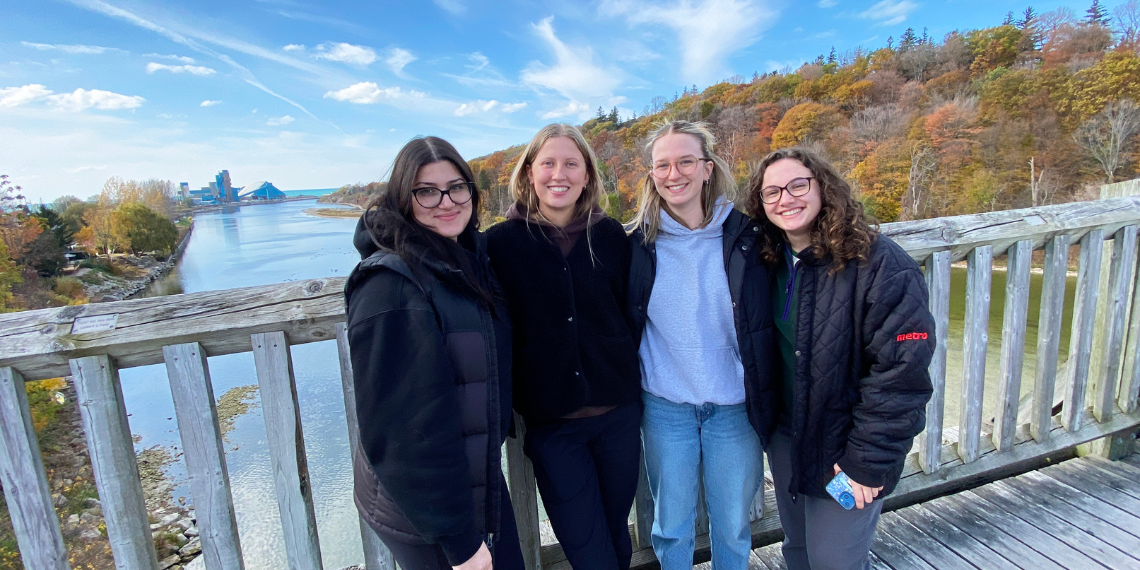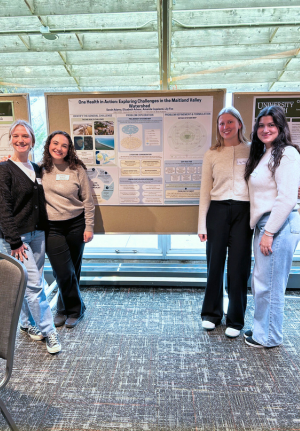One Health students take on complex, real-world challenges in ONEH*4000

Your client asks you to prepare a report and presentation detailing how to better manage the watershed along the Huron coastline near Goderich, with a focus on water quality and considering the interconnections between animal, human and environmental health. Where do you start?
This was the challenge that four Bachelor of One Health (BOH) students took on in ONEH*4000: Applications of One Health. They were tasked with working together to thoroughly research the complex and multi-layered problem, considering everything from the impacts of agricultural runoff on waterways, to residential development, invasive species, tourism, and economic stability, before coming up with One Health solutions for their client – in this case, the Maitland Valley Conservation Authority.
The course represents a culmination of the knowledge and skills students have gained over their studies in One Health. In their first year, BOH students get an introduction to thinking about health holistically and across systems. In second year, they review case studies, studying how others have integrated human, animal and environmental health to solve problems. In third year, students focus more on their area of emphasis, whether it be disease, complexity, and health; environment, food, and health; policy, economics, and health; or culture, society, and health. Then, in fourth year, students apply the knowledge and skills they’ve gained over their studies in One Health to a real health problem.
“In fourth year, we give them the real deal and that means they have a client and they’re working on a genuine problem with that client, consulting with community representatives, health managers and experts, and applying a One Health approach to the problem they’ve been given,” says Dr. Brian Husband, course instructor, Integrative Biology professor and BOH program chair. “We think it’s really important for the One Health students to finish their program off with a class like this. There aren’t many courses out there like it.”

The students started by mapping out all the potential elements connecting animal, environmental and human health to water quality, including those dependent on the water and management agencies. Through this process, they identified key themes, including land development, water treatment, extreme weather events and agricultural practices. They then conducted a literature review to confirm the importance of these connections and identify relevant best practices, such as the importance of buffer zones between agricultural land and waterways to reduce runoff.
From there, they took a trip to meet one on one with local experts, including in public health, agriculture, forestry and aquatic biology.
“It wasn’t until we actually went to the Maitland Valley and had a tour of the Conservation Authority that we realized that the problem wasn’t the technical part. They have technical solutions to fix these problems. It’s more the social aspect, getting people on board to implement those solutions,” says fourth-year BOH student Elizabeth Arbour.
While watershed managers had a strong understanding of best practices to maintain water quality, the biggest challenge was getting those practices adopted by farmers, residents and health managers. Residents weren’t always aware of problems like agricultural run-off, or proposed solutions, and didn’t have the time to attend the informational sessions and open houses intended to inform them. When they were aware of the problems and solutions, they didn’t always have the time or financial ability to implement them.
Financial constraints and changing policies also impacted managers, resulting in gaps in expertise and a lack of communication between agencies.

ONEH*4000 students won the best poster
prize at the One Health Research Day in November.
As the Maitland Valley Conservation Authority was the client, students focused solutions on what the organization could do to make change. To promote greater community understanding and engagement on watershed health, the students proposed the conservation authority develop an online platform for sharing watershed health updates, health information and discussion forums, as well as a volunteer program and incentives to encourage residents to adopt best practices. Students also recommended the conservation authority hire a watershed coordinator, with a science and social science background, who would facilitate communication and knowledge translation among the various experts and end-users.
With a solid foundation in the sciences, as well as the social sciences, the Bachelor of One Health students were uniquely prepared to tackle the case study from many different perspectives. Compared to students with only a science background, Husband noticed the class had a greater understanding of equity and representation issues and better understood the importance of incorporating a wide variety of voices. They also have a strong grasp of systems analysis, an essential skill in One Health.
“If we didn’t have those sociology and anthropology courses, I don’t know that we would have realized that the problem was community engagement. That would have gone right over our heads,” says Arbour. “I think the intersection of so many disciplines through the BOH degree helped us see where the root of the problem was.”
The course itself was purposively left broad, so the team of students could work through a complex, real-world problem on their own, choosing where to focus their research, how to organize their time, and what solutions to choose. Rather than lectures with set learning goals, classes were dynamic and collaborative, with students working together to brainstorm, debate and share.
“There was no straight and narrow path from problem to solution,” says Arbour. “One Health is not a straightforward approach; it’s iterative and needs to be adjusted as you go. That’s what so special about it.”